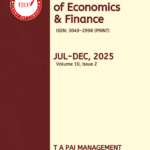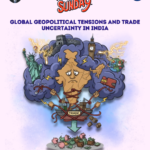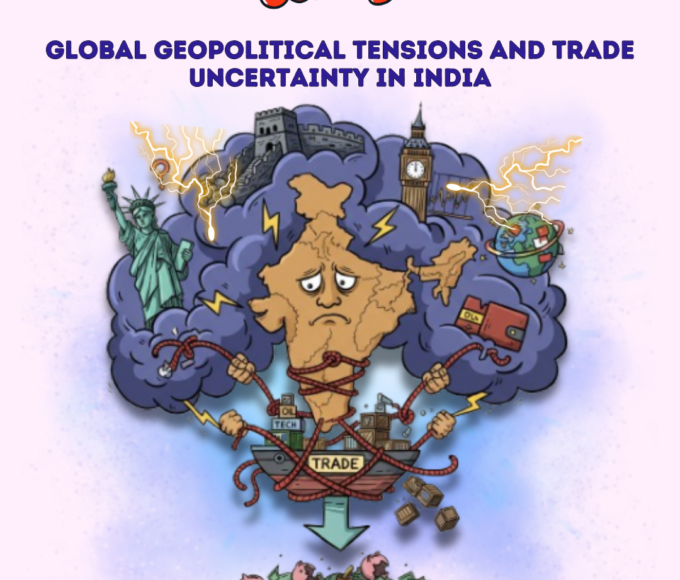INTRODUCTION
Financial markets of both developed, as well as emerging countries, usually have some kind of impact due to the United States Monetary Policy. Any changes made by the United States or even ramblings about potential changes can have both positive as well as negative impacts on the Exchange rates as well as Bond rates of Emerging Market Economies (EMEs). When Foreign Banks lend to firms in EMEs they essentially do them in terms of dollars. This creates a direct relation between the United States Monetary Policy and the credit cycles of the EMEs. The impact of the United States Monetary Policy is varied depending on the nation as well as the industries that are directly affected by them. The local lenders of EMEs do not have an offsetting impact on the foreign bank capital inflows, while the United States Monetary Policy affects the credit conditions both extensively as well as intensively. It has been found by many researchers that the spillover effect of the United States Monetary Policy is stronger for EMEs which have a higher risk.
FEDERAL OPEN MARKET COMMITTEE (FOMC) AND ITS ANNOUNCEMENTS
Monetary policy decisions in the United States have a significant impact on financial markets in both developed and developing countries. This was clear in the summer of 2013 when Federal Reserve Chairman Ben Bernanke first mentioned the prospect of decreasing the Federal Reserve Board’s security purchases on May 22. In the months that followed, this “tapering talk” had a significant negative influence on financial conditions in developing countries, with currency rates depreciating, bond spreads widening, and equities prices falling. A full-fledged balance of payments crisis appeared to be looming for several of the countries.
The US Federal Reserve chose to utilize the Federal Open Market Committee to undertake monetary policy changes in response to the Global Financial Crisis caused by the Sub-Prime Crisis in 2008. (FOMC). The FOMC chose to employ an unconventional monetary policy starting in 2008, as illustrated in the chart below.

Fig: Period of Unconventional Monetary Policy
The next era was highlighted by the Large-Scale Asset Purchase Program (LSAP), a programme of direct asset purchases, as well as prior indications on monetary policy direction. The research relied on high frequency variations in longer-term Treasury rates to detect monetary policy shocks because the federal funds futures rate no longer provided a suitable basis for doing so during the unconventional monetary policy phase. The identifying assumption is the same as for the traditional monetary policy period: Treasury rate fluctuations in a brief window around policy announcements are attributable to unanticipated changes in the US monetary policy stance.

Fig: Treasury Yields on FOMC days
Two-year Treasury rates are seen in the first panel of Chart 2. The period is characterised by medium-term patterns, in which yields declined between 2008 and 2011, stayed low from 2012 to 2013, and then rebounded, as well as shorter-term variations with more regularity. The vertical lines represent FOMC days where the percentage change in yields was 2 standard deviations below or above the period average.
The second panel shows the percentage change in yields on each of the FOMC days. Day-to-day changes in response to FOMC announcements that exceeded the two-standard deviation band around the average changes are indicated in red. The third panel compares the daily percentage change in rates on FOMC days to the daily percentage change in yields on all other days in the sample period. It shows that Treasury yields declined on FOMC days on average compared to non-FOMC days, and that the former had more tail events, such as sudden rises or drops in yields.
Finally, on the days of the FOMC announcements, we compare changes in 2-year Treasury yields to changes in 10-year Treasury yields in the last panel. On FOMC days, the fluctuations in 2-year and 10-year rates were significantly connected, as shown in the graph. There were only a few times when the yields’ near synchronisation was broken.
IMPACT OF US MONETARY POLICY ON INDIAN ECONOMY
There was a lot of research done to identify the effects of the US Monetary Policy on the Emerging Market Economies, various statistical as well as regression models were run to come to various conclusions. The most significant of which were the following.
Bhattarai et al (2018) estimated the spill-over effects of US QE on EMEs and assessed the differences in the responses in the policy of those economies, in which they found that the US quantitative easing (QE) resulted in currency appreciation for EMEs, as well as higher long-term bond rates, stock prices, and capital inflows.
Dahlhaus and Vasishtha (2014) studied the possible impact of the withdrawal of stimulus due to QE on EMEs which resulted them in finding for EMEs, the impact of QE tapering was predicted to be minor as a percentage of GDP. However, they warn that this might still create severe market volatility.
Gupta et al (2017) looked at the effects of QE and EMEs, in which they found In EMEs, QE had a considerable impact on exchange rates, stock prices, and bond yields.
Impact on India

Fig: INDM1 (Indian Money Supply), USMBASE (United States Monetary Base), EFFR (Effective Federal Funds Rate), INDBNCRE (Indian Bank Credit Rate), USD INR (Exchange Rate), and Indian Interest Rate changes
QE increased the money supply in the United States, which in turn increased capital inflows into emerging economies like India, increasing the economy’s money supply. At the same time, as the money supply shifted to growing economies such as India, the money supply in the United States shrank. As a result, there is a bi-directional causality between the money supply in India and the money supply in the United States. Indian Money Supply and Indian Bank credit rate also show a bi-directional causality due to the fact that the increase in bank credit will lead to increase in money supply.
QE increased the money supply in the United States. As a result, inflows into emerging economies like as India increased dramatically. This should have caused the Indian rupee to appreciate against the US dollar during QE and depreciate during tapering. In contrast, the rupee has been progressively losing strength versus the US dollar. This is because the Reserve Bank of India intervenes in the foreign exchange market to prevent the Indian currency from gaining too much, lowering volatility. The influence of QE on the currency rate has been negligible as a consequence of the RBI’s involvement.
CONCLUSION
According to our research, surprise US policy pronouncements have a big and significant influence on asset values in developing countries. Our estimates demonstrate that in developing nations, a surprise monetary easing, as assessed by a decline in the 2-year Treasury yield on the day of the FOMC announcement, leads to exchange rate appreciation, equities price gains, and bond yield reductions. A surprise tightening, as measured by an increase in the 2-year Treasury rate, on the other hand, has the opposite effect.
Evidence suggests that monetary policy shocks have a lesser spill-over in other advanced economies, such as the euro-zone, Japan, and the United Kingdom, owing to their weaker financial connectivity with emerging economies.
The signaling effect or portfolio rebalance effect, of US policy statements may have an impact on emerging economies. The findings highlight the impact of unexpected US monetary policy pronouncements for emerging economies and add credence to emerging market policymakers’ concerns in recent years. They emphasize the necessity for emerging economies to remain cautious in the face of US policy changes.
The Federal Reserve Bank of the United States, and to a lesser extent other advanced countries’ central banks, prepare the markets well in advance by providing unambiguous guidance, particularly when policy tightening is expected. The influence would then dissipate over a longer period until the day of the announcement, and emerging economies would be unlikely to see significant short-term financial upheaval.
REFERENCES:
- Jaswal, A., & Ahuja, B. R. (2021). Unconventional US Monetary Policy: Impact on the Indian Economy. The Indian Economic Journal, 0019466221998627.
- Bräuning, F., & Ivashina, V. (2020). US monetary policy and emerging market credit cycles. Journal of Monetary Economics, 112, 57-76.
- Gupta, P., Masetti, O., & Rosenblatt, D. (2017). Should emerging markets worry about US monetary policy announcements?. World Bank Policy Research Working Paper, (8100).
- Arora, V. B., & Cerisola, M. D. (2000). How does US monetary policy influence economic conditions in emerging markets?

















Good reading..